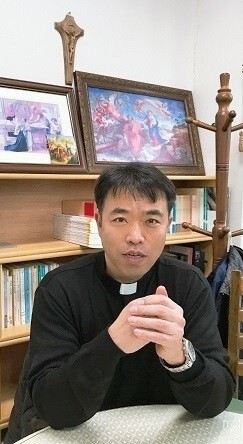hankyoreh
Links to other country sites 다른 나라 사이트 링크
[Interview] Understanding the Shincheonji cult

The outbreak of COVID-19, the disease caused by the novel coronavirus, has shined the public spotlight on the Shincheonji religious sect. Some of the biggest questions concern what behaviors in the church could have caused the virus to spread so rapidly and how such a new religion could have grown so dramatically.
These and other questions were answered in a telephone interview with Father Lee Geum-jae, who has been researching Shincheonji for the past 10 years and whose book “Shincheonji Fact Check” was published by Daughters of St. Paul this past September. Lee, who handles family pastoral care for the Catholic Diocese of Jeonju, has chaired the South Korean Catholic Pseudo Religion Action Committee since 2017.
Ten years ago, Lee was asked by a fellow Catholic to save their daughter, who had gotten entrapped by Shincheonji, and Lee has received several similar requests since then. During the course of helping Catholics extricate themselves from Shincheonji, he’s done extensive research into a religious movement that’s largely viewed as a cult.
“The roots of Shincheonji go back to the Jesus Christ Congregation Revival Association of Korea, founded by Park Tae-son. [Shincheonji leader and founder] Lee Man-hee spent 10 years at Faith Village before joining the Temple of the Tabernacle, which was founded by Yoo Jae-yeol (known as the ‘young servant’) in Gwacheon, Gyeonggi Province. After over two years there, Lee joined Baek Man-bong, who claimed to know when the Biblical end times would occur. Eventually, Lee founded Shincheonji in Anyang, Gyeonggi Province, on Aug. 14, 1980. According to Shincheonji doctrine, we’re living in the times prophesied by the Book of Revelation, and the witness that Revelation says Jesus will send is none other than Lee Man-hee himself. Shincheonji’s doctrine is largely similar to other new religious sects, but it’s made itself more palatable during its struggle with the established faiths,” the priest said.
“In a certain sense, Shincheonji has effectively been built up by cult therapists,” said Lee Geum-jae. Each time therapists have argued that Shincheonji’s doctrine contradicts the Bible, the movement has reinvented itself, revising its doctrine. Those who aren’t well-versed in the Bible or its teachings would be surprised by the thoroughness of Shincheonji’s indoctrination, Lee said.
“Shincheonji starts by teaching the basics of the Bible through 12 or 13 sessions, either one on one or in small groups. New trainees are paired with someone who’s disguised as another novice but is actually there to manage the sessions. After completing an exhaustive process of Bible study that runs for three hours a day, every Monday, Tuesday, Thursday, and Friday, for six or eight months, trainees are given a test. If they get at least a 90 on the test, they’re given an ID card and are registered as a “believer.” That’s when they start working as a ‘harvester [recruiter].’”
Close-knit network and constant supervision
“Shincheonji is organized into a network of small cells. Information is constantly being exchanged through text messages, and people always have a supervisor to whom they submit reports about their routine and from whom they receive instructions. Believers are kept absorbed in the work of the church, without any time off, not only on Wednesdays and Sundays but also on Saturdays and holidays. Students just go through the motions at school and employees only do the minimal amount of work to keep earning their salary: their real devotion belongs entirely to Shincheonji.”
“The reason that so many cases [of COVID-19] have been identified at Shincheonji churches is the result of how closed-off their services are,” Lee said. Whereas people at Protestant and Catholic services typically sit in chairs, Shincheonji followers sit close together on the floor, clap their hands, and shout amen; in such an environment, there’s a high likelihood of making physical contact with others or being sprayed by someone’s spittle.
“The real problem with Shincheonji is that it’s creating a society in which trust is impossible,” Lee said. The movement’s “harvesting” strategy is fundamentally fraudulent, relying on a dishonest scheme that involves tricking people into joining the religion.
“After learning information about the target of conversion, Shincheonji assigns from three to as many as 20 harvesters to that target. Each of the harvesters are given a role, and they make contact with the target through what appear to be random encounters. The harvesters will set up groups tailored to the target’s interests — a hiking club, football team, or craft circle, for example — and build relationships in that manner. One target who wasn’t able to leave his stationary shop to grab a bite to eat was brought lunch for six months in a row; an older woman who had trouble looking after her grandson was helped with that for a year. After building close relationships in that manner, they’ll lure the target into joining a Bible study. The harvesters will take advantage of the hard times that young people are going through by offering psychological counseling at ‘counseling cafés’ and then turn the subject to Bible study, suggesting that only the word of God offers a complete cure for their pain. Since the whole process is scripted, it’s hard for the targets to escape.”
“In our society today, people start to suspect you’re with Shincheonji if you’re too enthusiastic about anything,” Lee said sadly. “In Japan, people who were conned into joining a cult have later sued the cult, saying they want their youth back. Three young Protestants in South Korea filed a similar lawsuit against Shincheonji, and while the court ruled against two of the complainants because of a lack of evidence, one of them won the case.”
Failures of mainstream society and religion largely responsible for Shincheonji’s growthBut the priest added that mainstream religions and Korean society as a whole were largely responsible for so many people joining Shincheonji.
“Even if young people don’t believe in Lee Man-hee, they seem to find comfort and security in Shincheonji. Those who are anxious or in despair about making a living in Korean society are prone to delusions of grandeur when they’re treated like royalty. While the big churches and mainstream religions only promise material blessings and salvation in the next life, Shincheonji preaches the doctrine of salvation in this life. As long as believers are among the chosen 144,000, they’re told, they’ll be priests and kings, basically bigshots, when heaven comes to earth. In a society where people who don’t inherit success have to compete for it, those who fall behind are done for. Shincheonji is basically applying that worldly logic to faith when it promises that the chosen 144,000 will live a life of greatness.”
“By creating a materialistic society that revolves around money without giving young people any hope, the older generation has basically driven many young people [into the arms of Shincheonji]. The lesson taught by the Shincheonji phenomenon is that we need to build a society in which failure doesn’t mean the end of people’s dreams, a society in which true joy and love are found in faith, a society in which people warmly embrace each other,” Lee said.
By Cho Hyun, religion correspondent
Please direct comments or questions to [english@hani.co.kr]

Editorial・opinion
![[Column] Park Geun-hye déjà vu in Yoon Suk-yeol [Column] Park Geun-hye déjà vu in Yoon Suk-yeol](https://flexible.img.hani.co.kr/flexible/normal/500/300/imgdb/original/2024/0424/651713945113788.jpg) [Column] Park Geun-hye déjà vu in Yoon Suk-yeol
[Column] Park Geun-hye déjà vu in Yoon Suk-yeol![[Editorial] New weight of N. Korea’s nuclear threats makes dialogue all the more urgent [Editorial] New weight of N. Korea’s nuclear threats makes dialogue all the more urgent](https://flexible.img.hani.co.kr/flexible/normal/500/300/imgdb/original/2024/0424/7317139454662664.jpg) [Editorial] New weight of N. Korea’s nuclear threats makes dialogue all the more urgent
[Editorial] New weight of N. Korea’s nuclear threats makes dialogue all the more urgent- [Guest essay] The real reason Korea’s new right wants to dub Rhee a founding father
- [Column] ‘Choson’: Is it time we start referring to N. Korea in its own terms?
- [Editorial] Japan’s rewriting of history with Korea has gone too far
- [Column] The president’s questionable capacity for dialogue
- [Column] Are chaebol firms just pizza pies for families to divvy up as they please?
- [Column] Has Korea, too, crossed the Rubicon on China?
- [Correspondent’s column] In Japan’s alliance with US, echoes of its past alliances with UK
- [Editorial] Does Yoon think the Korean public is wrong?
Most viewed articles
- 1‘We must say no’: Seoul defense chief on Korean, USFK involvement in hypothetical Taiwan crisis
- 2N. Korean delegation’s trip to Iran shows how Pyongyang is leveraging ties with Moscow
- 346% of cases of violence against women in Korea perpetrated by intimate partner, study finds
- 4[Column] Park Geun-hye déjà vu in Yoon Suk-yeol
- 5‘Weddingflation’ breaks the bank for Korean couples-to-be
- 6Will NewJeans end up collateral damage in internal feud at K-pop juggernaut Hybe?
- 7Amnesty notes ‘erosion’ of freedom of expression in Korea in annual human rights report
- 8[Interview] Dear Korean men, It’s OK to admit you’re not always strong
- 9Korean government’s compromise plan for medical reform swiftly rejected by doctors
- 10[Editorial] Japan’s rewriting of history with Korea has gone too far